The new Bing interface is aimed at bringing you clean and decisive search results while helping you interact with your friends and network for a holistic search experience. In this interview, Stefan Weitz from Bing talks about the functionality of the new Bing, how it came about, and plans for its future.
Key Points
- The web has gone through a kind of seismic shift. Whereas before, it was all based primarily on text and links, there is now the ability to remodel the world in digital.
- In ethnographic studies, 68% of people told Bing that they were trying to actually do something with search, rather than just find information.
- During the studies, Bing also found that many people take information from the web and bring it to friends and family offline to help in decision-making.
- Sidebar is Bing’s social product, and attempts to take the offline action of engaging people in decision-making, and actually bring that into the online sphere.
- Sidebar not only brings people you know into search in a more natural way, it is actually able to show you people that you don’t even know that might be able to help you with your query.
- The goal is to make offline more visible online, and actually make that more efficient and effective in helping you do stuff.
- A majority of the people Bing studied said that search has gotten too complicated, and that they expect search to be able to organize and make sense of the information more effectively.
- Snapshot will take a lot of the tasks out of finding information on the web by actually organizing and summarizing information directly on the search result page.
- Bing’s entity engine has about three hundred and ten million objects in it right now, ranging from wine bottles to celebrities and artists.
- Bing prefers partnering with 3rd party services rather than trying to build or acquire them.
- Bing is currently working with Facebook, Twitter, Quora, LinkedIn, Foursquare, and Google+ in an attempt to make the most inclusive area for social activity on the web.
Full Interview Transcript
Eric Enge: Can you give me an overview of the new Bing announcement?
Stefan Weitz: As we have talked about before, the web has gone through a seismic shift. Where it used to be based primarily on text and links, it now more closely models the world in digital format. 5 billion social networking things are happening each day. The geospatial stuff clearly is a huge area because we now have gone past just buildings and streets and have moved into literally modeling all the stuff that we can touch, see, feel, and interact with into some digital format.
There are also a million plus applications across all the platforms, and these intelligently help you do something by understanding what it is you are talking about in the real world and linking that to a service or application which can help you do that. That is really where search has to go because search is really predicated on the structure of the web. That is the background for this big release. It is trying to create an experience that allows us to actually model or reflect that new reality of the web and reflect how people get things done in real life.
snapshot, which is what we call the center pane, is really catering to the fact that 68% of the people told us that they were trying to actually do something with search, not just find out information, which is a big shift from even a few years ago. And then, as far as sidebar is concerned, which is what we call the social section on the right rail of the page, that really came from watching how people were using social data to make decisions and to do things. We did lots of offline studies and went into people’s homes to see how they were doing things.
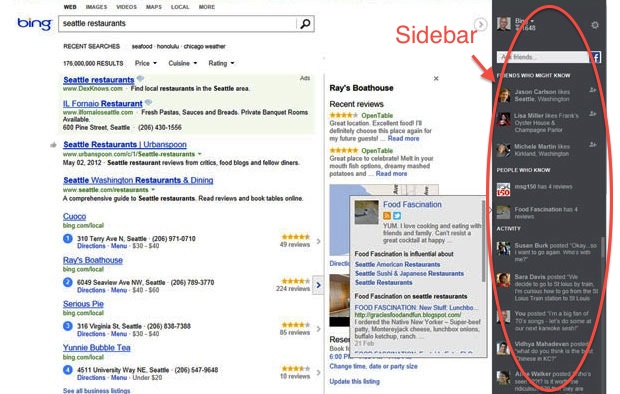
I remember sitting there one day and seeing this woman who spent hours and hours searching and printing out web pages about hotels and other travel options, and binding them in a three-ring binder and taking them to her husband to help her decide where they would go on vacation that year. At first, I thought she was a complete outlier. Then we started looking at how other folks were using search. They did not all print out and bind the results, but some put the information in an email, or bookmarked pages, or copied information into notepad. What emerged was this notion of using search to do research and get information, but ultimately they were not able to take an action until they were able to validate it with a human.
And, that’s where the sidebar came in. Sidebar says: How can we take the offline action of engaging people in decision-making and actually bring that into the online sphere? I was talking about it a few weeks ago and we were going back and forth on how to talk about this. I said, I equate this to the transformation that occurred when you look at US Mail versus email.
US Mail is a very solid, reliable, offline process, that has always been somewhat inefficient. Email came along and added efficiency to the entire process.
We think of sidebar the same way. Sidebar not only brings people into search in a more natural way, it enables us to actually show you people that you don’t even know who might be able to help you with your query. That’s the big problem, is that I may know that you were a part of the Phoenix BIOS Team but Joe may not. Now, Joe does a search for Phoenix BIOS and suddenly sees in sidebar that Eric Enge was one of the guys that was a part of that.
Well, he would have never known to ask you that question because he doesn’t know you well enough
The point is that it can expose you to information about your network that you may not have known. For example, I lived in Australia for three years. I built model rockets when I was a kid. These are the things you didn’t know.
Because of the proliferation of social data that people are putting online and tagging, suddenly the system is going to actually make those connections, where before that was impossible. It is the notion of bringing the offline online and actually making that more efficient and more effective in helping you do stuff.
Eric Enge: Estes Rockets by chance?
Stefan Weitz: Indeed, Estes Rockets with Double D engines I liked to use the big huge ones.
Eric Enge: Yeah of course, that’s what I did too. So anyway, that’s a great example.
Stefan Weitz: That’s the theory behind what you are seeing here in this new Bing experience. That pane now is really focused on presenting what search knows in a very clean interface so there is not a lot of distraction.
Most people were saying the social stuff was too distracting. Around 72% of the people we talked to actually said that search has gotten too complicated. 84% of the people actually said that they expect search to be able to organize and make sense of this information more effectively.
So, that’s what led to what you see now. The results are much cleaner than they used to be, there is more spacing, we have a nice gutter on the left-hand side, and it is far easier to scan the interface.
People are saying: “You have all this data, you understand all these services, you understand this new web of social data and applications and objects, do something with that.”
What snapshot is going to let us do, is actually know that Hotel Max is a hotel and offer a bunch of data about that hotel, including where it is at, reviews, photos and even the ability to go ahead and check rates on that particular place right here.
snapshot allows us to take a lot of the doing tasks and actually organize and summarize those things in a way that helps you interact directly on the page.
snapshot also tries to address the second big complaint we heard which was: there is too much data, you should do a better job of organizing this data.
Another good example I think actually is something like this for restaurants:
If I search for “San Francisco Italian”, it is a fairly ambiguous query, but it is not too bad. Bing will detect that it is likely a restaurant type query and add filters at the top that allow you to filter through your web results.
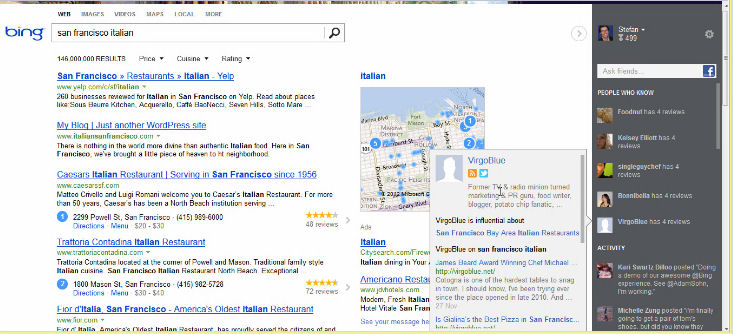
Also, as I scroll down, I can actually see the Italian restaurants. I get reviews, a map, hours, street view, and I can see the inside using a service called EveryScape. I can also book a reservation online through Open Table.
We partner with 3rd party services instead of trying to build or acquire them. There are probably something like a million apps out there today.
I talk to probably two dozen start-ups every week that are doing different cool things on the web. To think that we are ever going to be able to actually beat them, or out-execute them (when they are talking about 12 guys with half a million angel funding building some really interesting apps), it is just not likely.
We are trying to make snapshot the place where we integrate other people’s services and drive them traffic has tremendous value both to developers, but also of course to the users who can now actually do something with these algorithm results versus just clicking on and hope that it gets to a decent page.
Here is another good example using the search query “BMW 5 series”.
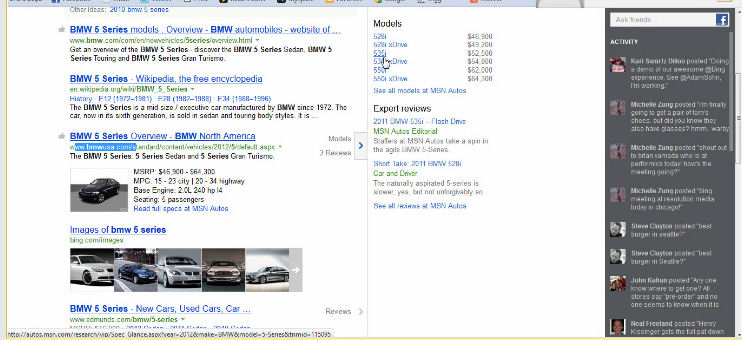
snapshot pulls in the official BMW website and data from other sites. We know about the BMW 5 series, the type of car, reviews, price, etc. We can go look at our entity engine and have complete information about the product.
What we have done here is literally take a bunch of data from across the web and re-associate it back with the entity from which it came. That’s a fundamental difference. Another example is Coldplay:
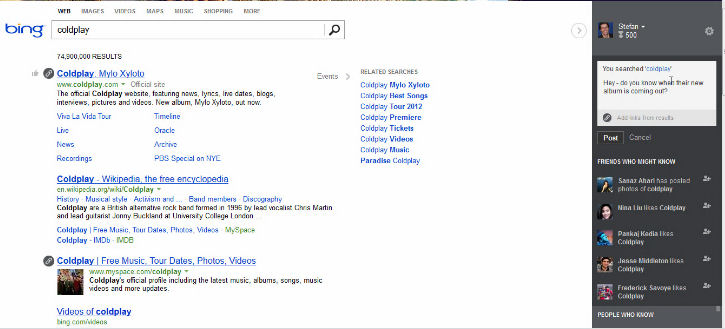
In the right rail, snapshot pops up and I get all their events.
We know Coldplay is a band, we know bands have events, we know events have times and places and we can again stitch all those things together in real time to augment the algorithm. Snapshot is only going to become more powerful over time as we do more and more of this integration.
The entity engine that we have currently has about three hundred and ten million objects in it right now. That being said, there are probably a hundred times that many entities in the actual planet, so we are aggressively building on it as fast as we can.
Eric Enge: What percentage of queries do you think you are addressing at this point?
Stefan Weitz: We are talking low numbers. You are not going to get a ton of the things here because they are scoped pretty much to restaurants, hotels, movies and events, people, and cars. They are all pretty high-frequency queries and you will see it, but you won’t see it for every query yet.
Eric Enge: What about sidebar?
Stefan Weitz:
What sidebar is doing is allowing you to more effectively bring offline behavior online. I can enter a query on Coldplay and have a section in the right rail called “friends who might know.”
In this case, we are looking at just Facebook friends and we are analyzing their public profiles, likes, shares, where they have lived, and photos. We are trying to see if any of these things give a hint, that potentially one of these people has information about your query.
The idea here is that I can literally now engage friends in conversations. I can go ahead and click on a friend and ask “hey, do you know when Coldplay’s new album is coming out?”
Eric Enge: You can pick who to ask which is nice.
Stefan Weitz: Yes. What is cool here is that that it will go out to Facebook, onto my wall, and all my friends will see it in their news feed, and the friends that I ask will receive the question as a message. As they answer my question, if I hover over in the activity feed, I will see their answers.
The other piece in sidebar is called “people who know.” In many queries, you may end up with no friends that know anything about what it is you are querying on. We want to invoke the wider web and we want to actually utilize data and social data from across the wider web to get you information on your query.
We can actually find Coldplay’s official Google Plus profile and put it there. Now you don’t have to know this person obviously, but it enables us to actually look across a number of different social data sources and attempt to find expertise and influence for those topics. In this case we think the Coldplay Google Plus page is the best page for that.
Eric Enge: Now presumably I won’t be able to message them directly because we are not yet connected, right?
Stefan Weitz: You can’t message them directly, no.
Eric Enge: Right. That makes sense of course because otherwise you would be flooding all these people with all kinds of communications and that would be ugly.
Stefan Weitz: Exactly, here is a cool example that really highlights the power of combining those two:
For San Francisco Italian restaurants, I may not have any friends who have any opinions about them. But, look what has happened.
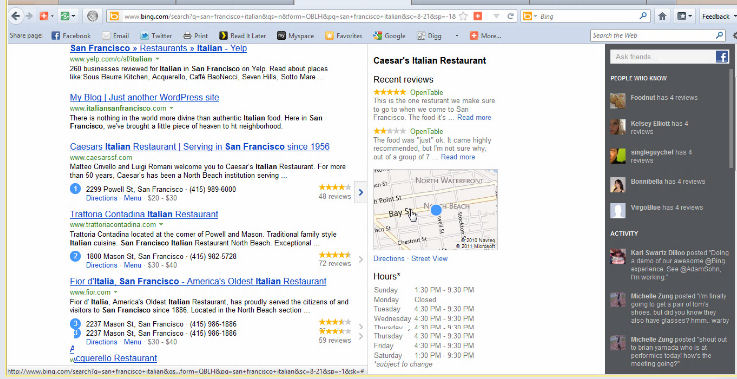
Bing has literally gone out and found people who have blogs and Twitter accounts that we think are influential about San Francisco Bay Area Italian restaurants. I can also literally scroll down and see people’s reviews on Italian restaurants in San Francisco.
Suddenly, I go from a lot of pages and links to nouns, to one where Bing is able to find a small blogger in San Francisco called FoodNut who happens to have data about San Francisco Italian restaurant entities. It is a fundamental shift in search.
Eric Enge: What are the social networks you support?
Stefan Weitz: We are currently working with Facebook, Twitter, Quora, LinkedIn, Foursquare, Google+ and Blogger. Our goal is to make this right rail, the right sidebar, the most inclusive area for social activity on the web. Four Square check-ins may actually be more interesting for me when I am looking for good seafood in Boston There is a bunch of cool stuff that we are going to enable in that right sidebar as we incorporate more of the social data in.
Another example is Windows 8. I can see people who know about Windows 8. Here I get Paul, I get Mary Joe and their Twitter accounts.
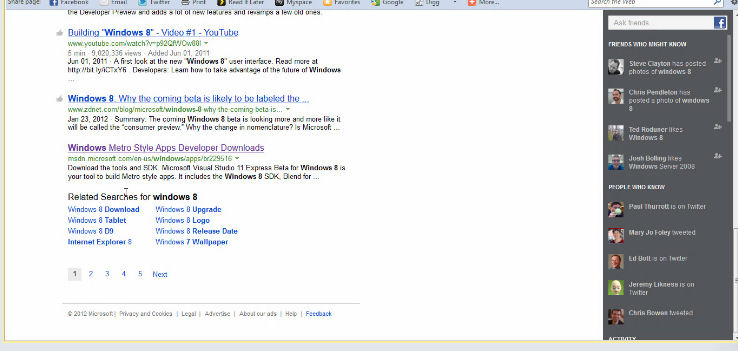
I am seeing their actual tweets about Windows 8 and a set of reviews.
Eric Enge: Right.
Stefan Weitz: It is focused on understanding the real world that we live in and helping to do things in that. It is focused on connecting people to those queries and letting you engage with those people in a way that helps you do things and it builds your network.
Eric Enge: Very cool. I imagine you have done some live user testing with this?
Stefan Weitz: Thousands of tests were run on the left-hand side on the new page (from fonts to color to spacing to caption lengths.)
For snapshot, we have done a lot of testing. I don’t think we have any real great data on that except for the fact that people appreciate being able to take action from that. I think the challenge we are going to have, frankly, is to get people to understand what to do with all of the features
On sidebar, we do a lot of work to understand what is the most interesting set of data to bring in there.
The right rail is going to take a bit of a user shift because they aren’t used to seeing that in search today. They are used to the way we used to have it, the way Google currently has it. Here it is about having the ability to do the same thing and get things there as well.
Eric Enge: So, did you end up getting a richer data set from Facebook in order to implement this?
Stefan Weitz: No, it’s what our agreement currently covers. It is public Likes, it is public profile data. What we have to do with Facebook is make sure that our Service Level Agreements are good so when somebody does post something or take something down, updates come very quickly.
If you “unlike” something in the old days, and didn’t catch it for five minutes, it wasn’t the end of the world. Here, if someone shares something they didn’t mean to share, being able to make sure that is deleted quickly is important.
It is important to also remember that this right rail, the sidebar, really is open. You can’t author into it today, but the whole point is that we are going to be including all these additional social networks and all the additional social signals.
Eric Enge: Was Facebook involved in any way in the development of this or consulted with it?
Stefan Weitz: Yeah, they definitely were consulted. We showed them the early mockups, along with other partners that we had that were involved, there were no surprises, let us put it that way. I know the folks who work at Facebook are pretty excited to see it roll out.
Eric Enge: Are you actually in touch with Google Plus development team or…?
Stefan Weitz: We are actually just crawling that. They don’t offer an API anyway so it wouldn’t be really easy.
Eric Enge: Do you have access to the LinkedIn data through the API as well?
Stefan Weitz: I don’t think we have even gotten down to how we are going to be using that honestly. I don’t know.
Eric Enge: For the other services, do you do it by crawl?
Stefan Weitz: It is just going to depend on what we want to do with the data and how fast it needs to be done. Crawling is not going to be very effective on check-ins, for example, for Four Square. With Quora, it is not necessarily critical real-time data, so it might be effective to crawl
Eric Enge: So when do you think this will be generally available?
Stefan Weitz: Well today, if you go to Bing.com/new you can opt in and get it today. Then, at the beginning of June-ish timeframe (I am not sure we have actually locked on that date), it should be available more generally.
Eric Enge: Right. Well, that’s very cool. The experiment with the social stuff is particularly interesting I am going to be really interested to see how this plays out for you in the market. Thanks Stefan!
Stefan Weitz: Thank you Eric!
